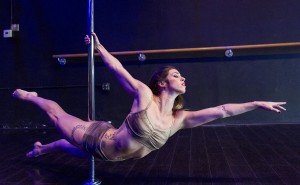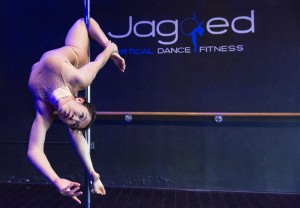UCLA alumna Drusilla Ray grasps the pole and pulls herself upward with a fluid movement. Spinning to the beat of Adele’s “Rolling in the Deep,” Ray inverts herself using only her arms and goes through a complicated series of motions that defy gravity.
Ray said she was surprised when she heard the results of the professional division of the Pacific Pole Championships in February – she had placed in a three-way tie for second place on the West Coast.
On Feb. 28, Ray and two other UCLA alumni competed in the annual Pacific Pole Championships, hosted by Pole Sport Organization in Los Angeles and featuring 250 professional and amateur competitors from around the West Coast. Ray placed fourth in the professional division after the three-way tie had been split by discriminating between the point breakdowns for each of the competitors. UCLA alumna Jessica Anderson-Gwin placed first in the professional division, and former Daily Bruin staffer Rhyn Cheung placed second in the amateur division.

(Jose Ubeda/Daily Bruin staff)
The competition awards points based on the presence and execution of technical skills, said Anderson-Gwin, a UCLA alumna and pole dancing instructor who danced to “Work Song” by Hozier.
Anderson-Gwin said the experience was a good chance to showcase pole dancing as exercise, competition and a form of artistic expression. She said she was initially reluctant to compete but was convinced by her students.
“It was very unexpected and awesome to be judged on my own merit,” Anderson-Gwin said. “I had a lot of students that entered the amateur division, so I thought I would give it a shot.”
Anderson-Gwin, who owns her own studio in Santa Monica called Jagged Vertical Dance and Fitness, said pole dancing is transformative both physically and emotionally, as she said dancers lose their inhibitions and insecurities when surrounded by a supportive community of other dancers.
In preparing for the competition, Anderson-Gwin said she and Ray were each other’s coaches and provided critique, feedback and encouragement during practices.
“We were our own personal judges,” Anderson-Gwin said.
Anderson-Gwin said Jagged Vertical Dance and Fitness was founded on a similar drive: to create a community where people of all ages and backgrounds could come together to express themselves through dance.
Chris Sea, a nurse at Ronald Reagan UCLA Medical Center and choreographer at The Vertitude in Canoga Park, said the strong sense of support from the pole dancing community provided him with the motivation to keep dancing.
Sea assisted Ray in choreographing her competition piece.
“When I started to dance, I loved the way pole dancing kept me focused on how I felt rather than how I looked,” Sea said.
Since her first class in 2011, Ray said dancing has become a cathartic experience for her, even though she said a stigma exists around the art form.

(Jose Ubeda/Daily Bruin staff)
While pole dancing is gaining in popularity among people of different backgrounds, Anderson-Gwin said its stigma makes showcasing her dedication to the art form more worthwhile.
“As recently as five or so years ago, pole dancing was oriented in the public eye more towards the stripper stereotype,” Anderson-Gwin said. “Now, there are a lot more people that are connecting with a story, and it’s becoming more artistic, dramatic and emotional, and less concerned with providing a spectacle.”
Ray said her style of pole dancing is analogous to contemporary and lyrical dancing in that it uses expression and emotion to convey a story to the audience.
For the Pacific Pole Championships, Ray danced to “Rolling in the Deep,” which she said was an unusual song choice for pole dancing because of its energy and upbeat rhythm.
Ray said her solo rendition of “Rolling in the Deep” focused on relationships and heartbreak, an experience that Ray said is universal.
“My piece discussed a breakup and how the couple involved copes with the heartbreak and the falling-out,” Ray said. “It’s ultimately about how people go through hard times and come out triumphant, which most people can relate to.”
While pole dancing is still gaining ground as a popular art form, Ray said finding a niche within the dancing community is essential to furthering growth as a dancer.
“Pole dancing feels initially uncomfortable because of the different movements, but I had a great support system,” Ray said. “It’s all about finding the community to support you and cheer you on when you need it.”
